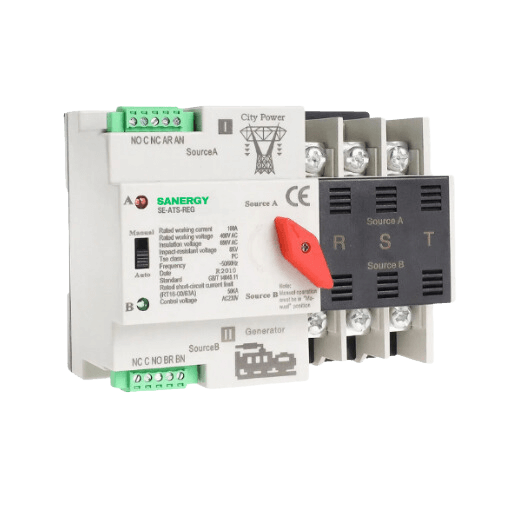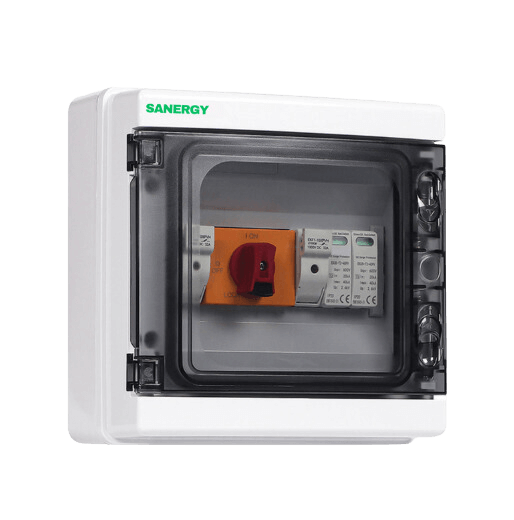Innovative Low-Voltage Solutions for Modern Living
Energizing Homes and Businesses with Reliable Efficiency and Safety

Exceptional Energy Efficiency
Our low-voltage appliances are designed to minimize energy consumption, reducing utility costs and promoting sustainable living.

Uncompromising Safety Standards
Each product undergoes rigorous testing and meets the highest safety standards, ensuring peace of mind for both residential and commercial users.

Innovative Technology
We leverage the latest advancements in electrical engineering to provide cutting-edge solutions that enhance functionality and convenience in everyday life.

Reliable Customer Support
Our dedicated support team is always ready to assist with expert advice, troubleshooting, and after-sales service, ensuring a seamless experience from purchase to installation.
Welcome to Sanergy Electric
At Sanergy Electric, we specialize in creating innovative low-voltage electrical appliances that bring efficiency, safety, and cutting-edge technology into your home and business. Our commitment to quality and customer satisfaction drives everything we do. Discover how our solutions can power your world more effectively.
Explore Our Featured Products
Discover our top-selling low-voltage appliances designed for efficiency and reliability.
Latest News & Updates
Stay informed with our company’s latest developments, innovations, and industry insights.
- No Comments
Voltage protectors are critical devices designed to safeguard electrical systems and equipment from power surges, voltage spikes, and fluctuations. These disturbances can cause significant damage to sensitive devices, leading to downtime, costly repairs, and system failures. In this blog post, we’ll delve into how voltage protectors work and explore their connection to Surge Protection Devices (SPDs), which are often used to prevent voltage-related issues.
What Are Voltage Protectors?
Voltage protectors, also known as voltage surge protectors or voltage regulators, are devices that automatically stabilize voltage within an electrical system. They prevent equipment from being exposed to harmful voltage spikes or dips that could compromise performance or cause damage. By ensuring a steady flow of electricity, voltage protectors help prolong the lifespan of sensitive electronic components and machinery.
The Connection Between Voltage Protectors and SPDs
Surge Protection Devices (SPDs) are designed to divert excess voltage, especially from transient surges caused by lightning strikes, switching operations, or electrical faults. While both voltage protectors and SPDs serve to protect electrical systems from harmful voltage disturbances, their functions differ slightly:
- Voltage Protectors: Primarily designed to maintain consistent voltage levels by regulating fluctuations. They ensure that voltage remains within a safe operating range.
- SPDs: Focused on absorbing or redirecting voltage surges to prevent them from reaching sensitive equipment.
Although they serve slightly different purposes, these two devices are often used together in electrical systems to provide comprehensive protection against both voltage spikes and steady-state fluctuations.
Why You Need Both Voltage Protectors and SPDs
In complex electrical systems, a combination of voltage protectors and SPDs offers ultimate protection. Voltage protectors maintain a steady voltage supply, while SPDs act as a safeguard against sudden surges. Together, they create a reliable defense against electrical disturbances, ensuring the longevity and functionality of equipment.
How Voltage Protectors Work in Conjunction with SPDs
Voltage protectors typically monitor and adjust voltage levels continuously, ensuring that systems operate within safe parameters. When voltage surges or drops beyond predefined limits, voltage protectors adjust the system’s supply to prevent equipment damage. SPDs, on the other hand, come into play when an exceptionally high surge (e.g., lightning or power grid fluctuations) occurs. They quickly absorb the excess voltage and direct it to the ground, protecting your equipment from damage.
Conclusion
Voltage protectors and SPDs are essential components of modern electrical systems, offering complementary protection against voltage-related issues. By incorporating both into your system, you ensure that your equipment remains safe from power surges, fluctuations, and other electrical hazards. For businesses that rely on sensitive electronic equipment, investing in these protective devices is a smart and cost-effective way to prevent downtime and maintain operational efficiency.
Optimize Your Electrical Protection Today
Looking for reliable voltage protectors and SPDs? Contact us to learn more about how our high-quality protection solutions can safeguard your electrical systems. Keep your equipment running smoothly and reduce the risk of costly damage.
- No Comments
As electric vehicles (EVs) gain popularity, ensuring safe charging becomes paramount. Surge Protection Devices (SPDs) protect AC chargers from voltage spikes, playing a crucial role in this process. In this blog, we’ll explore what SPDs are, their importance in EV charging infrastructure, and how they enhance the safety and longevity of charging systems.
What are SPDs?
Surge Protection Devices protect electrical devices from transient voltage surges caused by lightning strikes, power outages, or electrical malfunctions. In the context of EV chargers, SPDs safeguard sensitive components, ensuring both the charger and the vehicle remain unharmed.
Why SPDs are Essential for AC Chargers
- Protection Against Voltage Surges
EV chargers often face voltage spikes that can damage the charger and the vehicle’s battery management system. SPDs effectively mitigate these risks, ensuring safe charging. - Increased Reliability
By incorporating SPDs, AC chargers operate more reliably over time. This enhancement not only improves user experience but also reduces maintenance costs. - Compliance with Standards
Many regions require SPDs in charging stations to comply with safety regulations. Installing SPDs helps charger manufacturers meet these essential standards.
Choosing the Right SPD for Your EV Charger
When selecting an SPD for an AC charger, consider these factors:
- Type of SPD: Choose between Type 1, Type 2, and Type 3, each suited for different applications.
- Voltage Rating: Ensure the SPD is compatible with your charging system’s voltage.
- Response Time: A quicker response time provides better surge protection.
- Mounting Options: Select an SPD that fits your installation environment.
Installation and Maintenance
Proper installation of SPDs is crucial. Always have qualified professionals handle the installation to ensure compliance with local codes. Additionally, conduct regular maintenance checks to identify issues before they escalate.
Incorporating Surge Protection Devices in AC chargers for EVs is essential for safeguarding both the charger and the vehicle. As the EV market continues to grow, investing in quality SPDs enhances the reliability and longevity of charging infrastructure.
For more information on surge protection solutions for EV chargers, contact us today. Ensure your EV charging station is equipped with the best protection available!
Additional Resources
To learn more about electrical safety, visit the National Fire Protection Association’s website for valuable resources: NFPA Electrical Safety.
- No Comments
In today’s world, where reliable power is crucial for both businesses and homes, an Automatic Transfer Switch (ATS) is essential for maintaining uninterrupted power. Whether you’re managing a data center, healthcare facility, or residential property, understanding the importance of an ATS can help you avoid power disruptions. This blog post will explore what an ATS is, its benefits, and why it’s a key component of any reliable power system. Consider ATS for Uninterrupted Power Supply.
What is an Automatic Transfer Switch (ATS)?
An Automatic Transfer Switch is a device that automatically switches the power supply from the primary source (like the utility grid) to a backup source (such as a generator) when it detects a failure or disruption. Once the primary source is restored, the ATS switches the power back to it, thus ensuring a seamless transition with minimal disruption.
Key Features of ATS
- Automatic Operation: The ATS continuously monitors power sources and automatically switches to backup when the primary fails. Consequently, you experience minimal interruption.
- Seamless Transition: It reduces the risk of power loss, making the transition between sources smooth. As a result, your systems stay operational without any noticeable downtime.
- Remote Monitoring: Many modern ATS systems offer remote monitoring capabilities, which allows you to oversee operations from anywhere. Therefore, you can stay informed even when away.
Why is an ATS Essential?
- Uninterrupted Power Supply: In critical environments such as hospitals and data centers, an interruption in power can lead to severe consequences. Therefore, an ATS ensures power availability by switching instantly to a generator or alternate source during outages.
- Enhanced Safety: Automating power transfer reduces the risk of human error. Consequently, transitions are handled swiftly and safely, which is crucial in environments where delays could jeopardize safety and operations.
- Cost Efficiency: Power outages often lead to costly downtime. By minimizing downtime, an ATS quickly restores power and reduces the need for manual intervention. Thus, you save on labor costs.
- Compliance with Regulations: Many industries are required to have backup power systems to meet safety standards. Therefore, an ATS is often a critical component in meeting these requirements and ensuring compliance.
Types of Automatic Transfer Switches
- Open Transition ATS: This type briefly disconnects the load during the transfer process. It is suitable for non-critical loads.
- Closed Transition ATS: It provides a seamless transfer with no interruption by momentarily paralleling the two power sources. This is ideal for critical applications.
- Soft Loading Transfer Switch: Similar to a closed transition, but it manages the load between the two power sources. Consequently, it reduces stress on the system.
- Bypass Isolation ATS: This type allows maintenance on the ATS without disrupting power to the load. Therefore, it offers a high level of reliability.
Choosing the Right ATS for Your Needs
Selecting the appropriate ATS depends on several factors, including the criticality of the load, the type of power sources, and the specific application. Consulting with us can help you determine the best type of ATS for your needs.
An Automatic Transfer Switch is indispensable in any power management strategy, ensuring that power disruptions do not impact critical operations. By automating power transfer, an ATS provides peace of mind, knowing that your systems will remain operational even in the event of a power failure.
Whether you’re in a commercial, industrial, or residential setting, investing in a quality ATS can save you from the costly consequences of power outages. To integrate an ATS into your power system, consider reaching out to us. Explore our ATS options here: Sanergy ATS Uninterrupted Power Supply
For more information on other transfer switches, visit: Transfer Switch on Wikipedia
Get a Quote
Lorem Ipsum is simply dummy text of the printing and typesetting industry. Lorem Ipsum has been the industry’s.










